Echinoteuthis famelica
Richard E. YoungIntroduction
E. famelica is one of two common mastigoteuthd species in the region of the Hawaiian Archipelago.
Brief diagnosis:
An Echinoteuthis with ...
- a Pacific Ocean Distribution.
- barely detectable protective membranes on tentacular clubs.
Characteristics
- Tentacles
- Club with barely detectable protective membranes.
- Club suckers uniform in size over club until club diameter diminishes near tip where suckers become smaller.
 Click on an image to view larger version & data in a new window
Click on an image to view larger version & data in a new window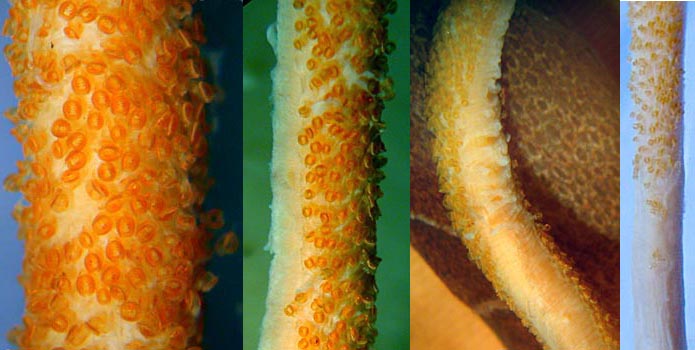
Figure. Four views of the club of E. familica, preserved, neotype. Left - Oral view in midregion of club. Left middle - Side view in midregion of club at lower magnification. Right middle - Aboral view in midregion of club. The distinctive mantle pigmentation is seen in the background. Right - Oral view of club base. The separate sucker patches on the latter may be an artifact of damage. The tentacle is a bit shriveled from long preservation. Photographs by R. Young.
- Club suckers slightly elongate, 0.36 mm in length, with 2-3 large, blunt knobs on each side of outer ring that project into aperature. Inner ring with 2 or 3 tiny rounded teeth on distal margin.
Scanning electron micrographs of the suckers can be found here.
- Head
- Beaks (2D). Description of the beaks can be found here.
- Beaks: Descriptions can be found here (3D): Lower beak; upper beak.
- Fins
- Fins slightly longer than broad.
- Anterior and posterior fin lobes absent.
- Photophores
- Eyelid photophore present; other photophores absent.
 Click on an image to view larger version & data in a new window
Click on an image to view larger version & data in a new window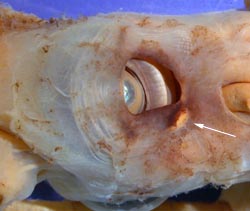
Figure. Lateral view of the head of E. famelica showing eye size and size of eyelid photophore (arrow), immature female, 140 mm ML, preserved, Hawaiian waters. The rather large eyelid photophore (ca 2.3% of ML in longest measurement) may be hidden by pigmentation. Photograph by R. Young.
Comments
More details of the description can found here.
E. famelica is very similar to E. atlantica from the central North Pacific in having large eyelid photophores, absence of all other photophores and fins that are slightly longer than wide. These two species clearly differ, however, in the size of the protective membrane on the tentacular clubs (well developed in E. atlantica and nearly absent in E. famelica). The small (37 mm ML, holotype) E. glaukopis from the Indian Ocean as described by Chun (1910) is very similar except for differences in the size and dentition of the club suckers. Since these latter features change with size, we can find no differences that separate E. glaukopis Chun, 1908 and it is probably synonymus with E. atlantica Joubin, 1933 or E. famelica Berry, 1909, but has priority over both. Until larger specimens of E. glaukopis are available from the Indian Ocean, we maintain all three species. We suspect, however, on the basis of the distinct protective membrane on the tentacular club in the illustrations of Chun (1910) that E. glaukopis and E. atlantica may be synonymus.
Nomenclature
The holotype is no longer extant (Sweeney, et al., 1988) and the specimen described here (immature female, 241 mm ML), USNM 1296965, is the neotype. Nesis (1980) incorrectly synonymized this species (it had been incompletely described at the time as Chiroteuthis famelica Berry, 1909) with Chiroteuthis acanthoderma (= Asperoteuthis acanthoderma).
Life History



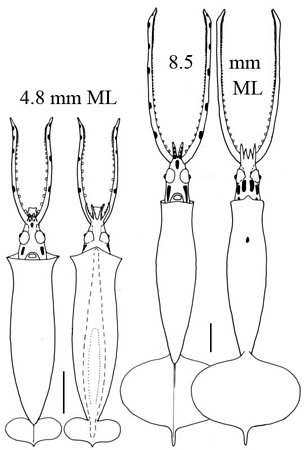
Figure. Ventral and dorsal views of two Paralarval stages of E. famelica. Thumbnail (far left): Ventral view showing relative sizes of the two paralarvae. Left - 4.8 mm ML paralarva, Hawaiian waters. Right: 8.5 mm ML paralarva, Hawaiian waters. Drawings from Young (1991).The scale bar is l mm.
Paralarvae
At 5 mm ML E. famelica paralarvae are separated from similar-sized paralarvae of Magnoteuthis microlucens, the only other common mastigoteuthid in Hawaiian waters, by the more slender shape, smaller eyes, more anterior digestive gland and tentacular suckers and chromatophores extending much of the tentacle length.
At 7-9 mm ML arms III are only small papillae; the mantle is very slender; fins are large (length 1/3 of ML) and without anterior or posterior fin lobes; eyes each have a silvery rostrum projecting ventrally or anteriorly. Funnel organ with tragus and antitragus recognizable at 25 mm ML. At 7-9 mm ML the absence of fin lobes, the slender shape, elongate fins, tentacular stalk suckers and chromatophores also distinguishes E. famelica from Magnoteuthis microlucens. At larger sizes, and, by at least 17 mm ML up to at least 40 mm ML, skin tubercules easily distinguish E. famelica. The differences between the two species diminish at sizes below 5 mm ML. The position of the digestive gland appears capable of distinguishing Magnoteuthis microlucens to at least 3.5 mm ML although the smallest E. familica paralarva examined was 4.8 mm ML.
Tubercles in paralarvae
Small multicuspid tubercles on mantle, funnel, head and aboral surface of arms seen in young of 17 - 42 mm ML. Most of the head tubercules are not visible in the photograph at the right but some on the funnel and its enlargement are visible.

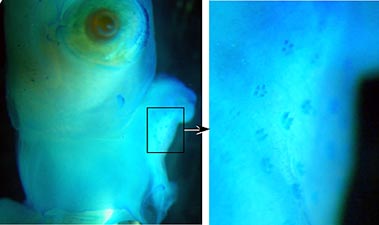
Figure. Left - Lateral view of preserved head and funnel of a paralarva of E. famelica, 35 mm ML, Hawaiian waters. Right - enlargement of a portion of the funnel, 35 mm ML, Hawaiian waters. Paralarva stained with methylene blue. Photographs by R. Young.
Distribution
Type locality: Vicinity of Kauai Island, Hawaiian Islands. Known only from the central north Pacific Ocean to about 3°S.
Vertical distribution
According to Young (1978), most specimens captured in his study were taken at depths between 675 and 800 m, both day and night. The two presummed contaminants were taken at 240 m during the day; the previous tow had fished at 700 m and captured three specimens.
Figure. Vertical distribution chart of E. famelica. Captures were made with both open and opening/closing trawls. Bar - fishing depth-range of opening/closing trawl. Circle - Modal fishing depth for either trawl. Blue-filled circle - Night capture. Yellow-filled circle - Day capture. Unfilled circle - probable contaminant from previous tow. Note the breaks in the x-axis. Chart modified from Young (1978).
References
Nesis, K. N. 1980. Taxonomic position of Chiroteuthis famelica Berry. Bull. Moscow Obslich. Ispyt. Prirody, Section Biology, 85: 59-66. [In Russian]
Sweeney, M.J., C.F.E. Roper, and F.G. Hochberg. 1988. Catalog of the type specimens of Recent Cephalopoda described by S. Stillman Berry. Malacologia, 29(1):7-19.
Young, R. E. 1978. Vertical distribution and photosensitive vesicles of pelagic cephalopods from Hawaiian waters. Fish. Bull., 76: 583-615.
Young, R. E. (1991). Chiroteuthid and related paralarvae from Hawaiian waters. Bull. Mar. Sci., 49: 162-185.
Title Illustrations

| Scientific Name | Mastigoteuthis famelica |
|---|---|
| Location | Hawaiian waters |
| Sex | Female |
| View | Ventral |
| Size | 241 mm ML |
| Collection | USNM 1296965 |
| Type | Neotype |
| Image Use |
 This media file is licensed under the Creative Commons Attribution-NonCommercial License - Version 3.0. This media file is licensed under the Creative Commons Attribution-NonCommercial License - Version 3.0.
|
| Copyright |
© 2004

|
| Scientific Name | Mastigoteuthis famelica |
|---|---|
| Location | Hawaiian waters |
| Sex | Female |
| View | Dorsal |
| Size | 241 mm ML |
| Collection | USNM 1296965 |
| Type | Neotype |
| Image Use |
 This media file is licensed under the Creative Commons Attribution-NonCommercial License - Version 3.0. This media file is licensed under the Creative Commons Attribution-NonCommercial License - Version 3.0.
|
| Copyright |
© 2004

|
| Scientific Name | Mastigoteuthis famelica |
|---|---|
| Comments | Drawing of neotype. |
| Sex | Female |
| View | Dorsal and ventral |
| Size | 241 mm ML |
| Image Use |
 This media file is licensed under the Creative Commons Attribution-NonCommercial License - Version 3.0. This media file is licensed under the Creative Commons Attribution-NonCommercial License - Version 3.0.
|
| Copyright |
© 2004

|
About This Page

University of Hawaii, Honolulu, HI, USA
Page copyright © 2018
 Page: Tree of Life
Echinoteuthis famelica .
Authored by
Richard E. Young.
The TEXT of this page is licensed under the
Creative Commons Attribution-NonCommercial License - Version 3.0. Note that images and other media
featured on this page are each governed by their own license, and they may or may not be available
for reuse. Click on an image or a media link to access the media data window, which provides the
relevant licensing information. For the general terms and conditions of ToL material reuse and
redistribution, please see the Tree of Life Copyright
Policies.
Page: Tree of Life
Echinoteuthis famelica .
Authored by
Richard E. Young.
The TEXT of this page is licensed under the
Creative Commons Attribution-NonCommercial License - Version 3.0. Note that images and other media
featured on this page are each governed by their own license, and they may or may not be available
for reuse. Click on an image or a media link to access the media data window, which provides the
relevant licensing information. For the general terms and conditions of ToL material reuse and
redistribution, please see the Tree of Life Copyright
Policies.
- First online 25 February 2004
- Content changed 29 August 2016
Citing this page:
Young, Richard E. 2016. Echinoteuthis famelica . Version 29 August 2016 (under construction). http://tolweb.org/Echinoteuthis_famelica/19513/2016.08.29 in The Tree of Life Web Project, http://tolweb.org/




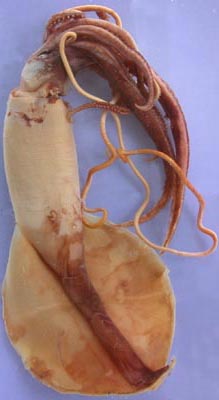
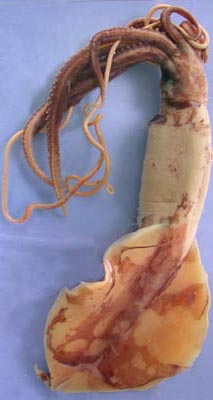
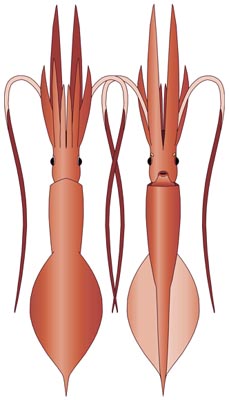
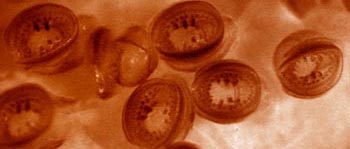






 Go to quick links
Go to quick search
Go to navigation for this section of the ToL site
Go to detailed links for the ToL site
Go to quick links
Go to quick search
Go to navigation for this section of the ToL site
Go to detailed links for the ToL site